Episodes
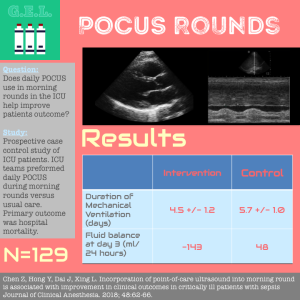
Monday Sep 03, 2018
POCUS Rounds in the ICU
Monday Sep 03, 2018
Monday Sep 03, 2018
We know that POCUS can be used in making many diagnoses in the critically ill patient. It also can help guide management. So why not perform it every day on every patient? That is the idea behind this article on POCUS rounds in the ICU. These authors compare patients who received a daily POCUS to those who did not - with real patient-centered outcomes! Is it too good to be true? Is a daily POCUS rounds something you should be doing in your ICU?
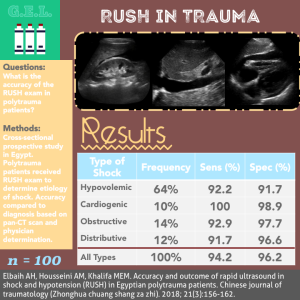
Monday Aug 20, 2018
The RUSH Exam in Polytrauma
Monday Aug 20, 2018
Monday Aug 20, 2018
The RUSH exam is a family favorite. It's a reliably easy to recall hypotensive protocol that uses ultrasound to help determine the etiology of a patient's shock. Well here's a new idea - trauma patient's can be in shock too, right? So maybe we should perform a full RUSH exam instead of just a measly EFAST? Well...hold your horses there kiddo, there may be more to think about with this one.
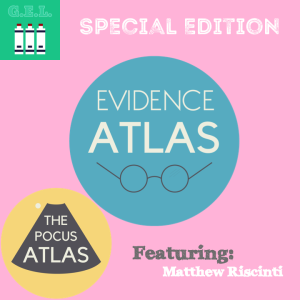
Monday Aug 06, 2018
The Evidence Atlas
Monday Aug 06, 2018
Monday Aug 06, 2018
The POCUS Atlas is a beautiful resource. You may be familiar with the Image Atlas, a crowd-sourced compendium of sonographic pathology created to help others learn point of care ultrasound. These same talented creators have recently unleashed the Evidence Atlas - another entirely free resource that summarizes much of the best evidence in POCUS. In this special edition interview, we talk with Matthew Riscinti, co-founder of the POCUS Atlas, about how this all came to be. We even do a quick review of one of the Evidence Atlas articles!

Monday Jun 18, 2018
Chest Pain in the Emergency Department
Monday Jun 18, 2018
Monday Jun 18, 2018
This seems like a good idea. Chest pain is common. Ultrasound can see many causes of chest pain. Sooooo lets use ultrasound in patients with chest pain to help with decision making. Well, wipe the smile from your face validity because it is not that simple. This article takes an interesting approach in performing a rather complex "focused" echo in the emergency department and uses it to determine the patient's disposition. The main goal was to see how accurate this method could be. Let's see how this pans out.
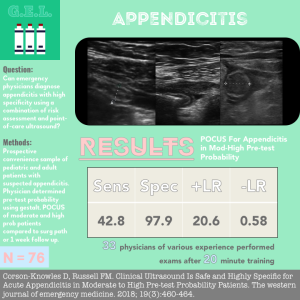
Monday Jun 04, 2018
POCUS for Appendicitis in Moderate to High Pre-test Probability
Monday Jun 04, 2018
Monday Jun 04, 2018
Point of care ultrasound for appendicitis has a long and checkered past. It is well-established as first line in the pediatric population, but less accepted in adults. Some studies show that is great, other studies show that it is about as useful as an air conditioner in Antarctica. This article hits on the idea that perhaps we should risk stratify our patients and focus on ruling in the disease in those that are more likely to have it. Sound intriguing? Check it out.
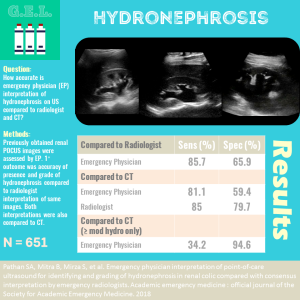
Monday May 21, 2018
Emergency Physician Accuracy in Identifying and Grading Hydronephrosis
Monday May 21, 2018
Monday May 21, 2018
As more and more emergency physicians are using point-of-care ultrasound to assess for hydronephrosis in the setting of renal colic, it becomes important to determine how accurate they are for the diagnosis. This study takes previously recorded clips and compares the EP interpretation to a radiologists interpretation. The idea is to see if EPs can determine the presence or absence of hydro, as well as the grade of it, compared to a radiologist looking at the same images. Both are then compared to CTs done in the same patients for a second standard of comparison. This brings to light interesting findings as well as questions regarding the best standard of comparison in this practice.
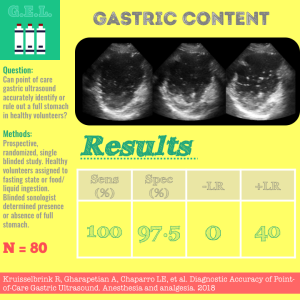
Monday May 07, 2018
POCUS to Diagnosis Gastric Content
Monday May 07, 2018
Monday May 07, 2018
Usually in ultrasound we think of the stomach as something that gets in the way or gives us a false positive LUQ view in the FAST. But what if visualizing the stomach could actually be helpful? In some scenarios, such as prior to anesthesia, sedation, or a procedure, it might be nice to know if the patient has a full stomach with the potential to aspirate. These authors test out the accuracy of POCUS for this purpose in healthy volunteers.
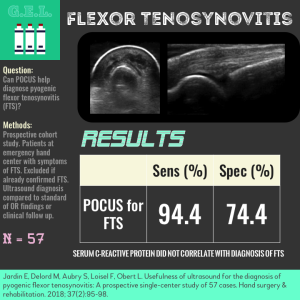
Monday Apr 23, 2018
Flexor Tenosynovitis
Monday Apr 23, 2018
Monday Apr 23, 2018
Flexor tenosynovitis is a bad infection in the finger. It usually requires surgical intervention for treatment. The current standard of diagnosis is primarily clinical, sometimes with the help of blood tests. Since the disease process should produce a fluid collection around the flexor tendon sheath - the idea in this study is that perhaps ultrasound can visualize that fluid and clench the diagnosis. This would lead to ensuring the proper treatment to those who need it and potentially avoiding an unnecessary operation for those who don't. So how well does this plan work out? Should we be doing this routinely?
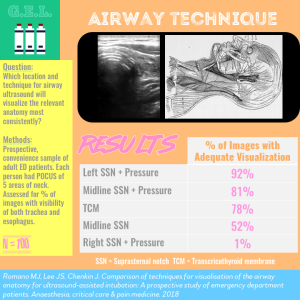
Monday Apr 09, 2018
Technique for Ultrasound During Endotracheal Intubation
Monday Apr 09, 2018
Monday Apr 09, 2018
We already know that ultrasound can be used to help with endotracheal intubation. The idea is that you can visualize the trachea and esophagus while someone is attempting to place the endotracheal tube - and see which one lights up with the air-filled balloon. Since some people are actually doing this now, it might be important to figure out the best way to perform this ultrasound exam. Where do you put the transducer? Do you add pressure? How long does this take? Some of these answers are obvious, but this study takes a look to figure out where you can get the most bang for your airway ultrasound buck.
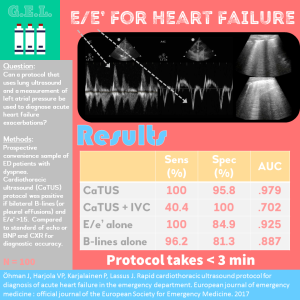
Monday Mar 26, 2018
E/e‘ for Acute Heart Failure
Monday Mar 26, 2018
Monday Mar 26, 2018
Point of care ultrasound protocols for acute heart failure are a dime a dozen these days - for good reason. Ultrasound has made this diagnosis way easier in the acute care setting. The question now is who can come up with the best protocol - something easy, accurate, and fast. These authors put their spin on the traditional heart and lungs protocol by including a measurement of the left atrial pressure. How does it hold up?

